Academic Research: Strategy, Structure, and Business Performance
VerifiedAdded on 2021/04/17
|8
|2081
|116
Report
AI Summary
This report provides a literature review analyzing the relationship between organizational strategy and organizational structure. It defines strategy as a set of activities designed to exploit core competencies and gain a competitive advantage, and structure as the formal reporting relationships, processes, and decision-making aspects of an organization. The report explores the main concepts of their relationship, including the importance of alignment and strategic fit, as well as the strengths and weaknesses of these concepts and their contributions to knowledge. The analysis highlights that organizational structure must support the organizational strategy, emphasizing the need for coordination between strategy, structure, environment, and core competencies. The report concludes that successful strategic transformations depend on the appropriateness of the changes and the need for a close coordination of all organizational functions. References to relevant academic papers are included.
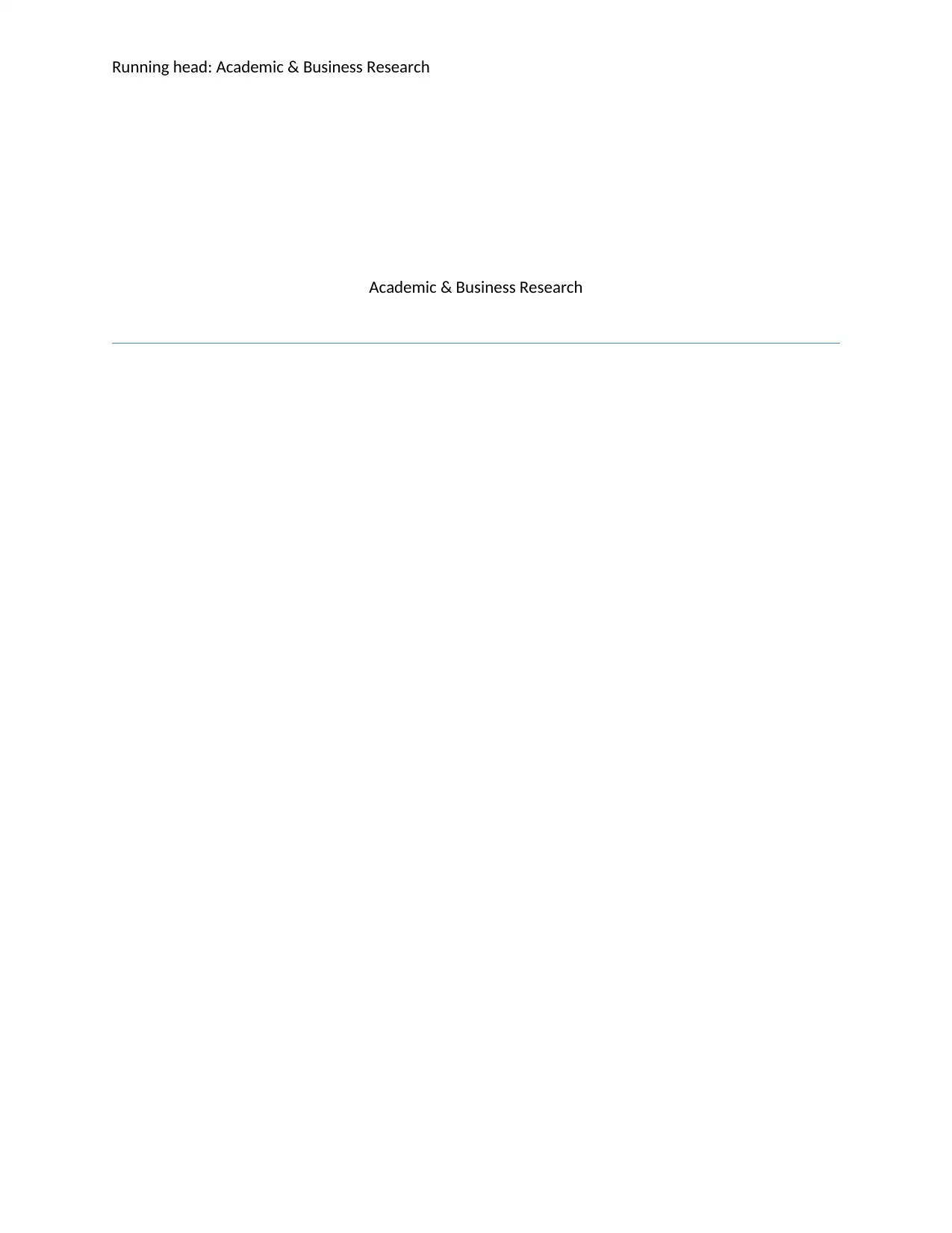
Running head: Academic & Business Research
Academic & Business Research
Academic & Business Research
Paraphrase This Document
Need a fresh take? Get an instant paraphrase of this document with our AI Paraphraser
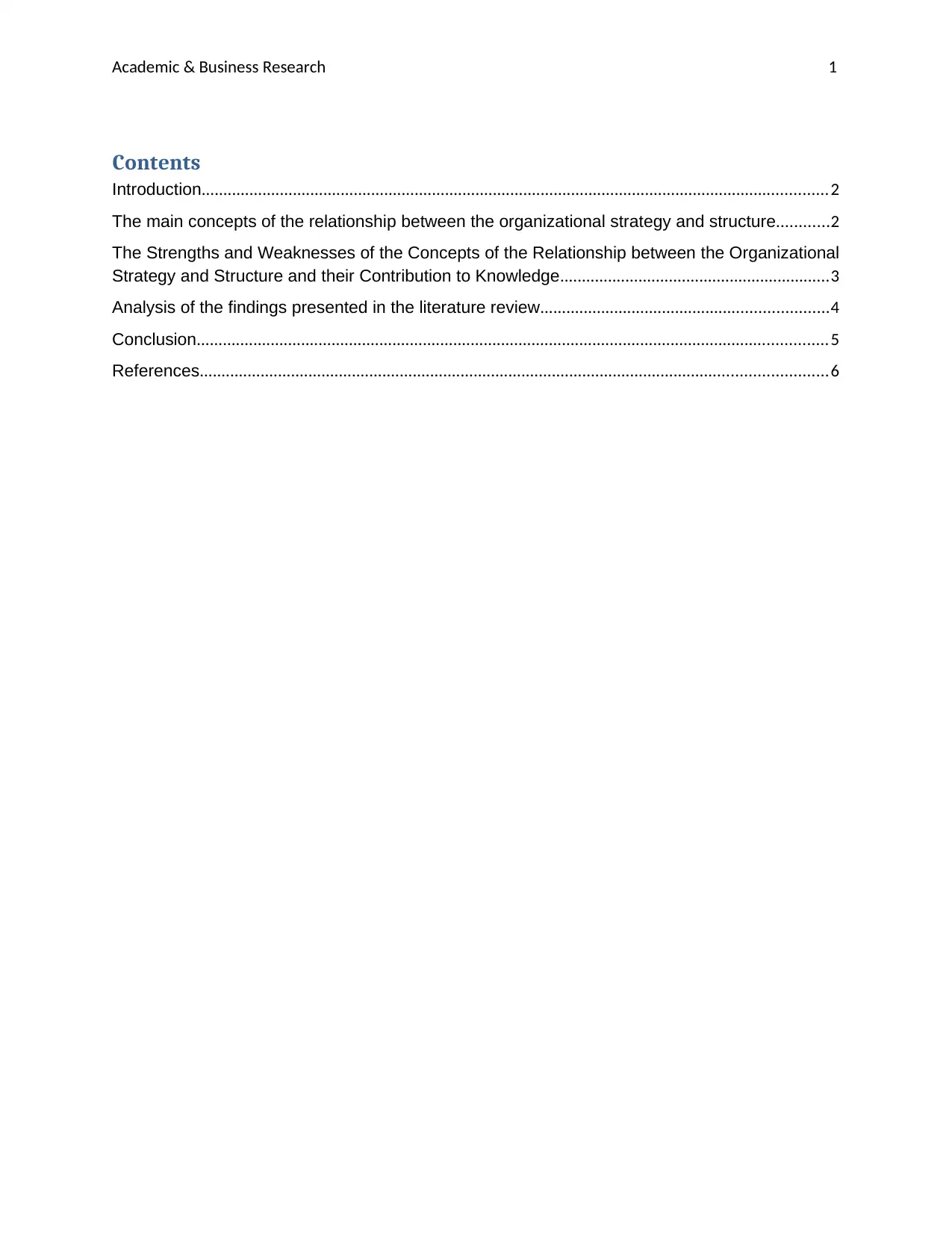
Academic & Business Research 1
Contents
Introduction................................................................................................................................................2
The main concepts of the relationship between the organizational strategy and structure............2
The Strengths and Weaknesses of the Concepts of the Relationship between the Organizational
Strategy and Structure and their Contribution to Knowledge..............................................................3
Analysis of the findings presented in the literature review..................................................................4
Conclusion.................................................................................................................................................5
References................................................................................................................................................6
Contents
Introduction................................................................................................................................................2
The main concepts of the relationship between the organizational strategy and structure............2
The Strengths and Weaknesses of the Concepts of the Relationship between the Organizational
Strategy and Structure and their Contribution to Knowledge..............................................................3
Analysis of the findings presented in the literature review..................................................................4
Conclusion.................................................................................................................................................5
References................................................................................................................................................6
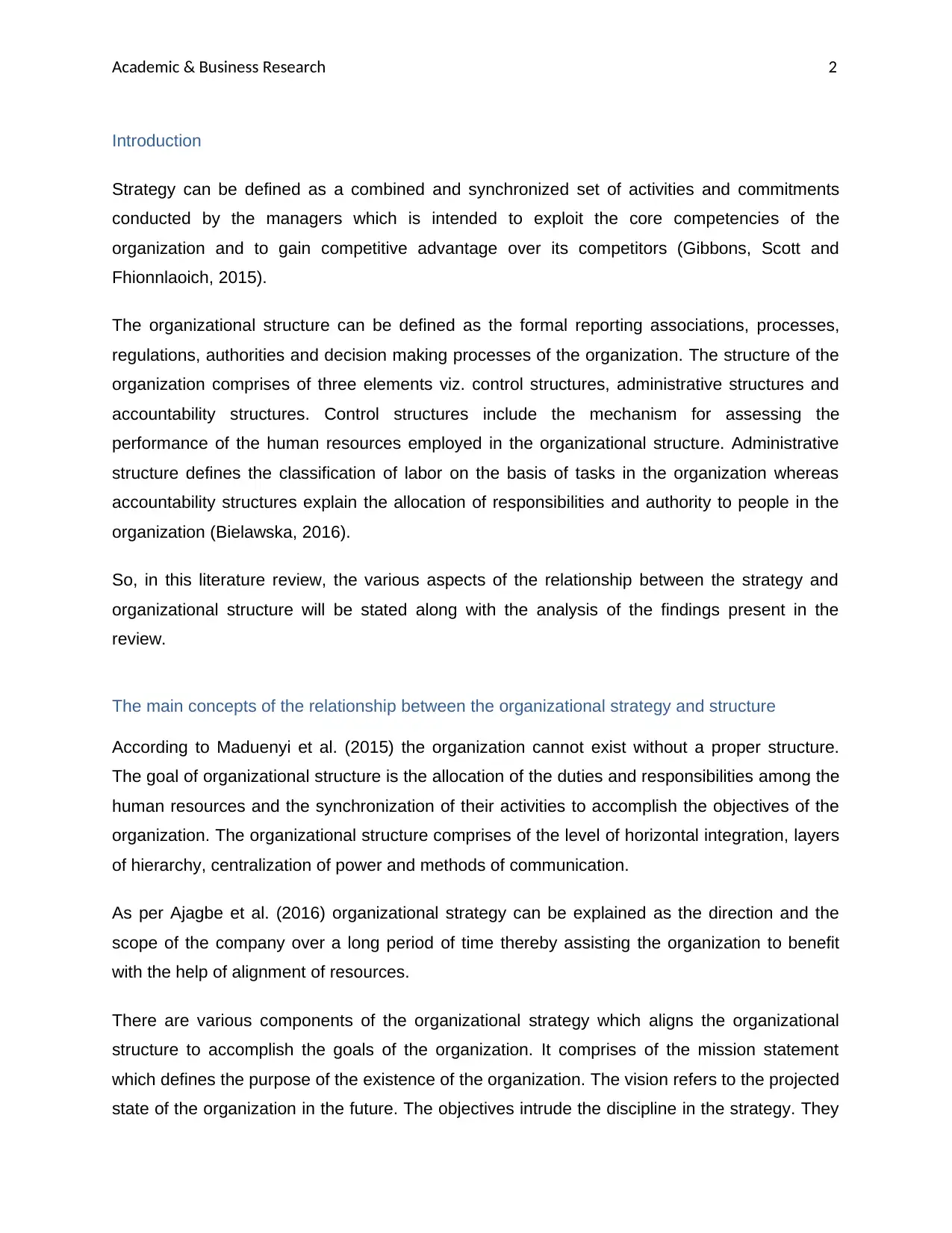
Academic & Business Research 2
Introduction
Strategy can be defined as a combined and synchronized set of activities and commitments
conducted by the managers which is intended to exploit the core competencies of the
organization and to gain competitive advantage over its competitors (Gibbons, Scott and
Fhionnlaoich, 2015).
The organizational structure can be defined as the formal reporting associations, processes,
regulations, authorities and decision making processes of the organization. The structure of the
organization comprises of three elements viz. control structures, administrative structures and
accountability structures. Control structures include the mechanism for assessing the
performance of the human resources employed in the organizational structure. Administrative
structure defines the classification of labor on the basis of tasks in the organization whereas
accountability structures explain the allocation of responsibilities and authority to people in the
organization (Bielawska, 2016).
So, in this literature review, the various aspects of the relationship between the strategy and
organizational structure will be stated along with the analysis of the findings present in the
review.
The main concepts of the relationship between the organizational strategy and structure
According to Maduenyi et al. (2015) the organization cannot exist without a proper structure.
The goal of organizational structure is the allocation of the duties and responsibilities among the
human resources and the synchronization of their activities to accomplish the objectives of the
organization. The organizational structure comprises of the level of horizontal integration, layers
of hierarchy, centralization of power and methods of communication.
As per Ajagbe et al. (2016) organizational strategy can be explained as the direction and the
scope of the company over a long period of time thereby assisting the organization to benefit
with the help of alignment of resources.
There are various components of the organizational strategy which aligns the organizational
structure to accomplish the goals of the organization. It comprises of the mission statement
which defines the purpose of the existence of the organization. The vision refers to the projected
state of the organization in the future. The objectives intrude the discipline in the strategy. They
Introduction
Strategy can be defined as a combined and synchronized set of activities and commitments
conducted by the managers which is intended to exploit the core competencies of the
organization and to gain competitive advantage over its competitors (Gibbons, Scott and
Fhionnlaoich, 2015).
The organizational structure can be defined as the formal reporting associations, processes,
regulations, authorities and decision making processes of the organization. The structure of the
organization comprises of three elements viz. control structures, administrative structures and
accountability structures. Control structures include the mechanism for assessing the
performance of the human resources employed in the organizational structure. Administrative
structure defines the classification of labor on the basis of tasks in the organization whereas
accountability structures explain the allocation of responsibilities and authority to people in the
organization (Bielawska, 2016).
So, in this literature review, the various aspects of the relationship between the strategy and
organizational structure will be stated along with the analysis of the findings present in the
review.
The main concepts of the relationship between the organizational strategy and structure
According to Maduenyi et al. (2015) the organization cannot exist without a proper structure.
The goal of organizational structure is the allocation of the duties and responsibilities among the
human resources and the synchronization of their activities to accomplish the objectives of the
organization. The organizational structure comprises of the level of horizontal integration, layers
of hierarchy, centralization of power and methods of communication.
As per Ajagbe et al. (2016) organizational strategy can be explained as the direction and the
scope of the company over a long period of time thereby assisting the organization to benefit
with the help of alignment of resources.
There are various components of the organizational strategy which aligns the organizational
structure to accomplish the goals of the organization. It comprises of the mission statement
which defines the purpose of the existence of the organization. The vision refers to the projected
state of the organization in the future. The objectives intrude the discipline in the strategy. They
⊘ This is a preview!⊘
Do you want full access?
Subscribe today to unlock all pages.

Trusted by 1+ million students worldwide
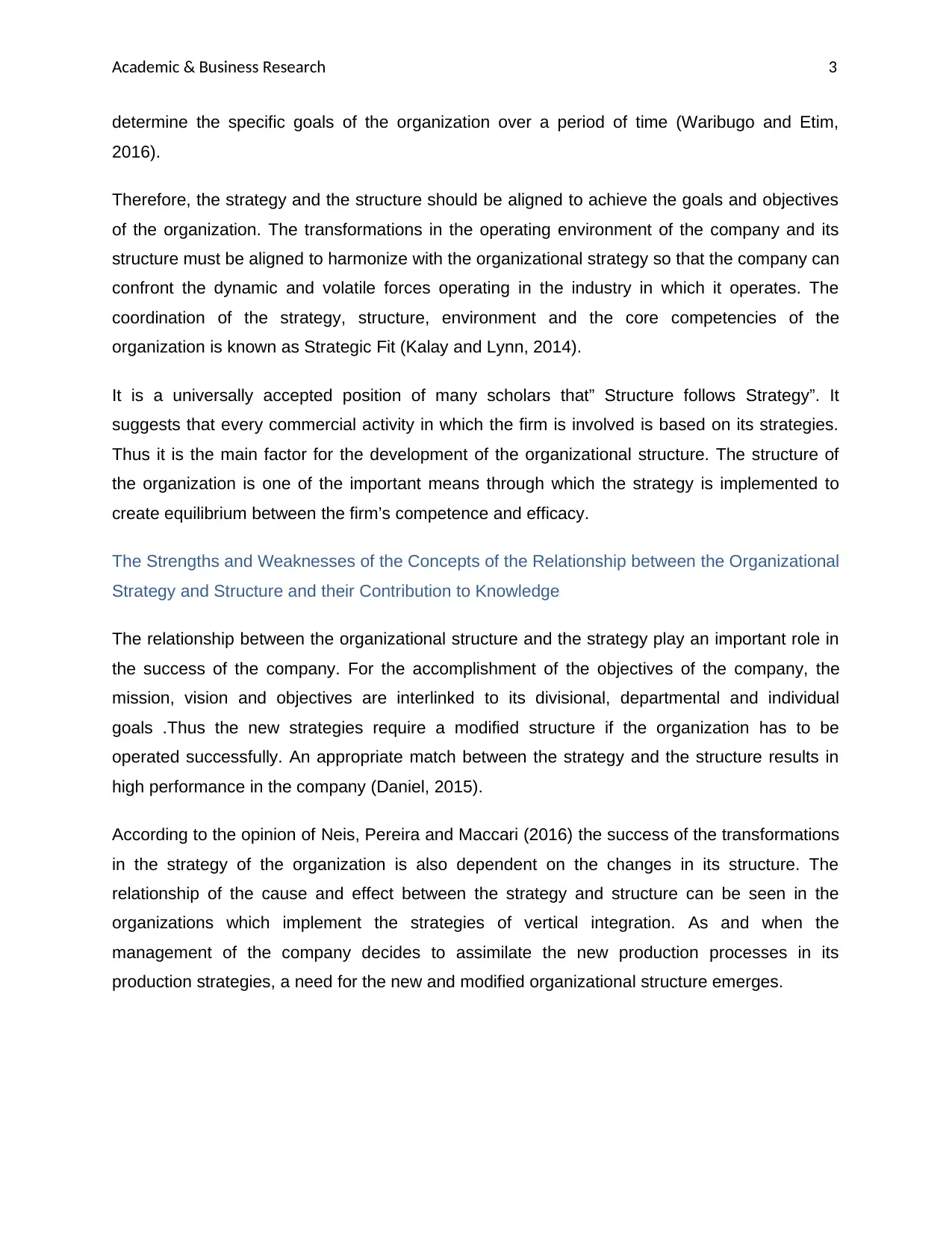
Academic & Business Research 3
determine the specific goals of the organization over a period of time (Waribugo and Etim,
2016).
Therefore, the strategy and the structure should be aligned to achieve the goals and objectives
of the organization. The transformations in the operating environment of the company and its
structure must be aligned to harmonize with the organizational strategy so that the company can
confront the dynamic and volatile forces operating in the industry in which it operates. The
coordination of the strategy, structure, environment and the core competencies of the
organization is known as Strategic Fit (Kalay and Lynn, 2014).
It is a universally accepted position of many scholars that” Structure follows Strategy”. It
suggests that every commercial activity in which the firm is involved is based on its strategies.
Thus it is the main factor for the development of the organizational structure. The structure of
the organization is one of the important means through which the strategy is implemented to
create equilibrium between the firm’s competence and efficacy.
The Strengths and Weaknesses of the Concepts of the Relationship between the Organizational
Strategy and Structure and their Contribution to Knowledge
The relationship between the organizational structure and the strategy play an important role in
the success of the company. For the accomplishment of the objectives of the company, the
mission, vision and objectives are interlinked to its divisional, departmental and individual
goals .Thus the new strategies require a modified structure if the organization has to be
operated successfully. An appropriate match between the strategy and the structure results in
high performance in the company (Daniel, 2015).
According to the opinion of Neis, Pereira and Maccari (2016) the success of the transformations
in the strategy of the organization is also dependent on the changes in its structure. The
relationship of the cause and effect between the strategy and structure can be seen in the
organizations which implement the strategies of vertical integration. As and when the
management of the company decides to assimilate the new production processes in its
production strategies, a need for the new and modified organizational structure emerges.
determine the specific goals of the organization over a period of time (Waribugo and Etim,
2016).
Therefore, the strategy and the structure should be aligned to achieve the goals and objectives
of the organization. The transformations in the operating environment of the company and its
structure must be aligned to harmonize with the organizational strategy so that the company can
confront the dynamic and volatile forces operating in the industry in which it operates. The
coordination of the strategy, structure, environment and the core competencies of the
organization is known as Strategic Fit (Kalay and Lynn, 2014).
It is a universally accepted position of many scholars that” Structure follows Strategy”. It
suggests that every commercial activity in which the firm is involved is based on its strategies.
Thus it is the main factor for the development of the organizational structure. The structure of
the organization is one of the important means through which the strategy is implemented to
create equilibrium between the firm’s competence and efficacy.
The Strengths and Weaknesses of the Concepts of the Relationship between the Organizational
Strategy and Structure and their Contribution to Knowledge
The relationship between the organizational structure and the strategy play an important role in
the success of the company. For the accomplishment of the objectives of the company, the
mission, vision and objectives are interlinked to its divisional, departmental and individual
goals .Thus the new strategies require a modified structure if the organization has to be
operated successfully. An appropriate match between the strategy and the structure results in
high performance in the company (Daniel, 2015).
According to the opinion of Neis, Pereira and Maccari (2016) the success of the transformations
in the strategy of the organization is also dependent on the changes in its structure. The
relationship of the cause and effect between the strategy and structure can be seen in the
organizations which implement the strategies of vertical integration. As and when the
management of the company decides to assimilate the new production processes in its
production strategies, a need for the new and modified organizational structure emerges.
Paraphrase This Document
Need a fresh take? Get an instant paraphrase of this document with our AI Paraphraser
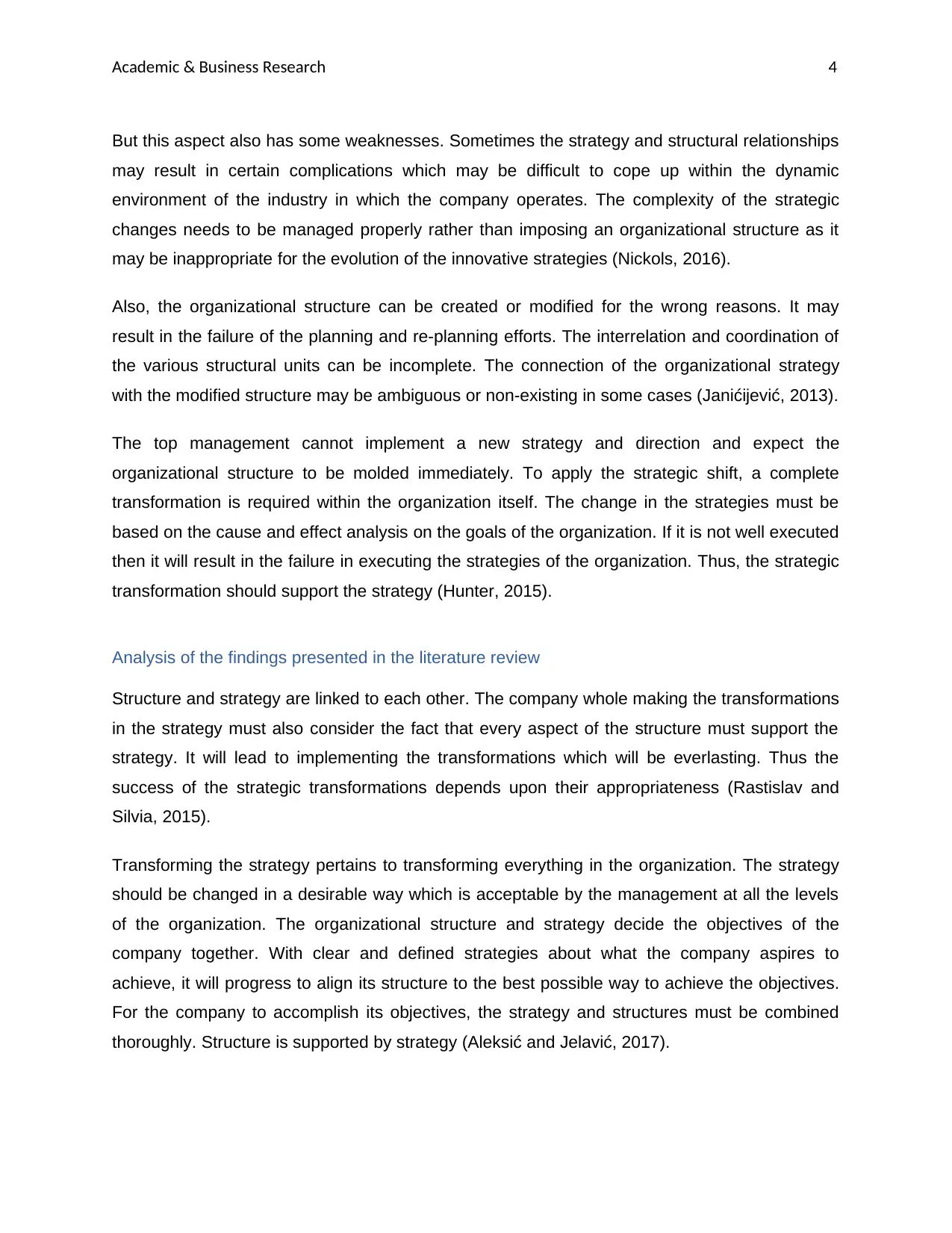
Academic & Business Research 4
But this aspect also has some weaknesses. Sometimes the strategy and structural relationships
may result in certain complications which may be difficult to cope up within the dynamic
environment of the industry in which the company operates. The complexity of the strategic
changes needs to be managed properly rather than imposing an organizational structure as it
may be inappropriate for the evolution of the innovative strategies (Nickols, 2016).
Also, the organizational structure can be created or modified for the wrong reasons. It may
result in the failure of the planning and re-planning efforts. The interrelation and coordination of
the various structural units can be incomplete. The connection of the organizational strategy
with the modified structure may be ambiguous or non-existing in some cases (Janićijević, 2013).
The top management cannot implement a new strategy and direction and expect the
organizational structure to be molded immediately. To apply the strategic shift, a complete
transformation is required within the organization itself. The change in the strategies must be
based on the cause and effect analysis on the goals of the organization. If it is not well executed
then it will result in the failure in executing the strategies of the organization. Thus, the strategic
transformation should support the strategy (Hunter, 2015).
Analysis of the findings presented in the literature review
Structure and strategy are linked to each other. The company whole making the transformations
in the strategy must also consider the fact that every aspect of the structure must support the
strategy. It will lead to implementing the transformations which will be everlasting. Thus the
success of the strategic transformations depends upon their appropriateness (Rastislav and
Silvia, 2015).
Transforming the strategy pertains to transforming everything in the organization. The strategy
should be changed in a desirable way which is acceptable by the management at all the levels
of the organization. The organizational structure and strategy decide the objectives of the
company together. With clear and defined strategies about what the company aspires to
achieve, it will progress to align its structure to the best possible way to achieve the objectives.
For the company to accomplish its objectives, the strategy and structures must be combined
thoroughly. Structure is supported by strategy (Aleksić and Jelavić, 2017).
But this aspect also has some weaknesses. Sometimes the strategy and structural relationships
may result in certain complications which may be difficult to cope up within the dynamic
environment of the industry in which the company operates. The complexity of the strategic
changes needs to be managed properly rather than imposing an organizational structure as it
may be inappropriate for the evolution of the innovative strategies (Nickols, 2016).
Also, the organizational structure can be created or modified for the wrong reasons. It may
result in the failure of the planning and re-planning efforts. The interrelation and coordination of
the various structural units can be incomplete. The connection of the organizational strategy
with the modified structure may be ambiguous or non-existing in some cases (Janićijević, 2013).
The top management cannot implement a new strategy and direction and expect the
organizational structure to be molded immediately. To apply the strategic shift, a complete
transformation is required within the organization itself. The change in the strategies must be
based on the cause and effect analysis on the goals of the organization. If it is not well executed
then it will result in the failure in executing the strategies of the organization. Thus, the strategic
transformation should support the strategy (Hunter, 2015).
Analysis of the findings presented in the literature review
Structure and strategy are linked to each other. The company whole making the transformations
in the strategy must also consider the fact that every aspect of the structure must support the
strategy. It will lead to implementing the transformations which will be everlasting. Thus the
success of the strategic transformations depends upon their appropriateness (Rastislav and
Silvia, 2015).
Transforming the strategy pertains to transforming everything in the organization. The strategy
should be changed in a desirable way which is acceptable by the management at all the levels
of the organization. The organizational structure and strategy decide the objectives of the
company together. With clear and defined strategies about what the company aspires to
achieve, it will progress to align its structure to the best possible way to achieve the objectives.
For the company to accomplish its objectives, the strategy and structures must be combined
thoroughly. Structure is supported by strategy (Aleksić and Jelavić, 2017).
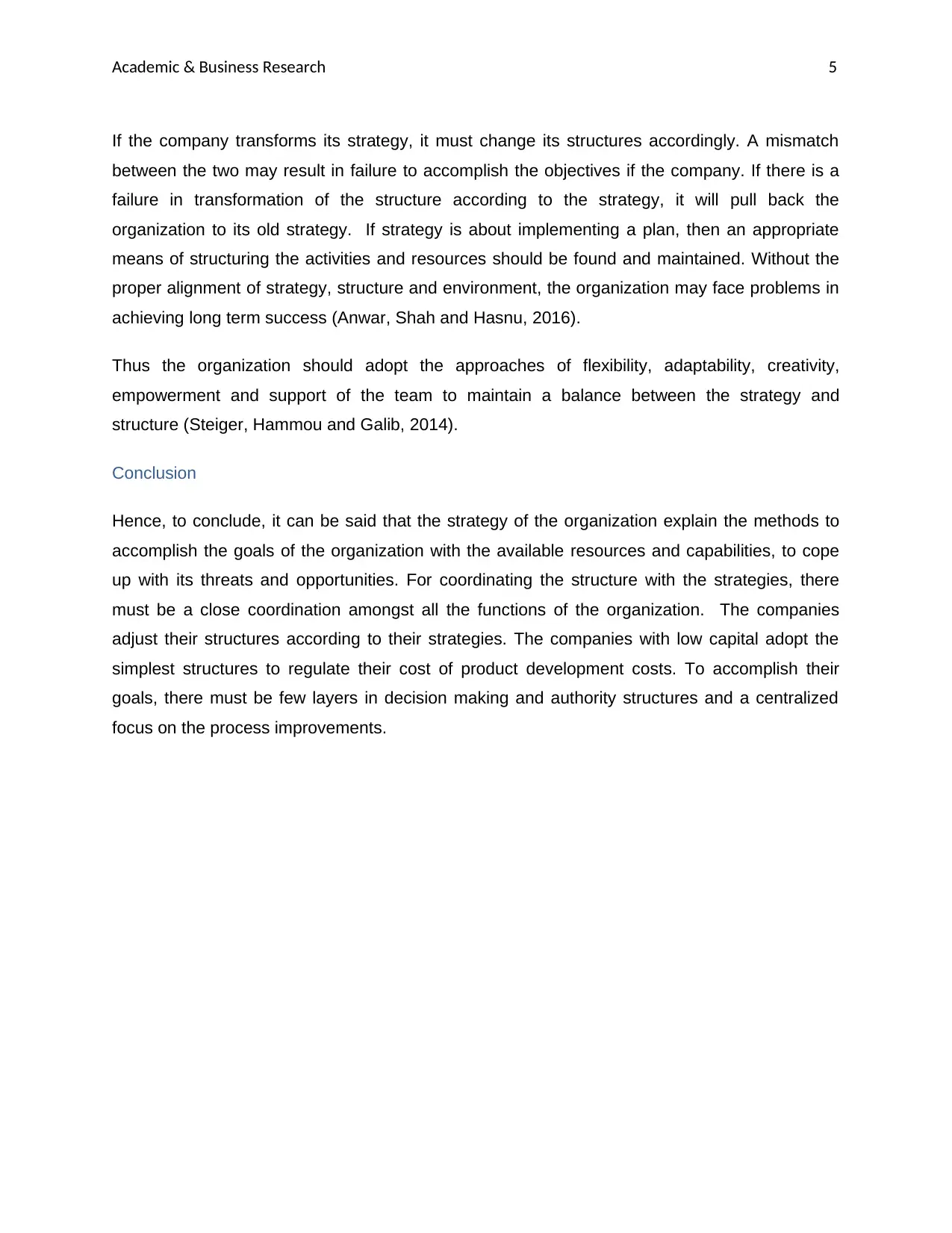
Academic & Business Research 5
If the company transforms its strategy, it must change its structures accordingly. A mismatch
between the two may result in failure to accomplish the objectives if the company. If there is a
failure in transformation of the structure according to the strategy, it will pull back the
organization to its old strategy. If strategy is about implementing a plan, then an appropriate
means of structuring the activities and resources should be found and maintained. Without the
proper alignment of strategy, structure and environment, the organization may face problems in
achieving long term success (Anwar, Shah and Hasnu, 2016).
Thus the organization should adopt the approaches of flexibility, adaptability, creativity,
empowerment and support of the team to maintain a balance between the strategy and
structure (Steiger, Hammou and Galib, 2014).
Conclusion
Hence, to conclude, it can be said that the strategy of the organization explain the methods to
accomplish the goals of the organization with the available resources and capabilities, to cope
up with its threats and opportunities. For coordinating the structure with the strategies, there
must be a close coordination amongst all the functions of the organization. The companies
adjust their structures according to their strategies. The companies with low capital adopt the
simplest structures to regulate their cost of product development costs. To accomplish their
goals, there must be few layers in decision making and authority structures and a centralized
focus on the process improvements.
If the company transforms its strategy, it must change its structures accordingly. A mismatch
between the two may result in failure to accomplish the objectives if the company. If there is a
failure in transformation of the structure according to the strategy, it will pull back the
organization to its old strategy. If strategy is about implementing a plan, then an appropriate
means of structuring the activities and resources should be found and maintained. Without the
proper alignment of strategy, structure and environment, the organization may face problems in
achieving long term success (Anwar, Shah and Hasnu, 2016).
Thus the organization should adopt the approaches of flexibility, adaptability, creativity,
empowerment and support of the team to maintain a balance between the strategy and
structure (Steiger, Hammou and Galib, 2014).
Conclusion
Hence, to conclude, it can be said that the strategy of the organization explain the methods to
accomplish the goals of the organization with the available resources and capabilities, to cope
up with its threats and opportunities. For coordinating the structure with the strategies, there
must be a close coordination amongst all the functions of the organization. The companies
adjust their structures according to their strategies. The companies with low capital adopt the
simplest structures to regulate their cost of product development costs. To accomplish their
goals, there must be few layers in decision making and authority structures and a centralized
focus on the process improvements.
⊘ This is a preview!⊘
Do you want full access?
Subscribe today to unlock all pages.

Trusted by 1+ million students worldwide
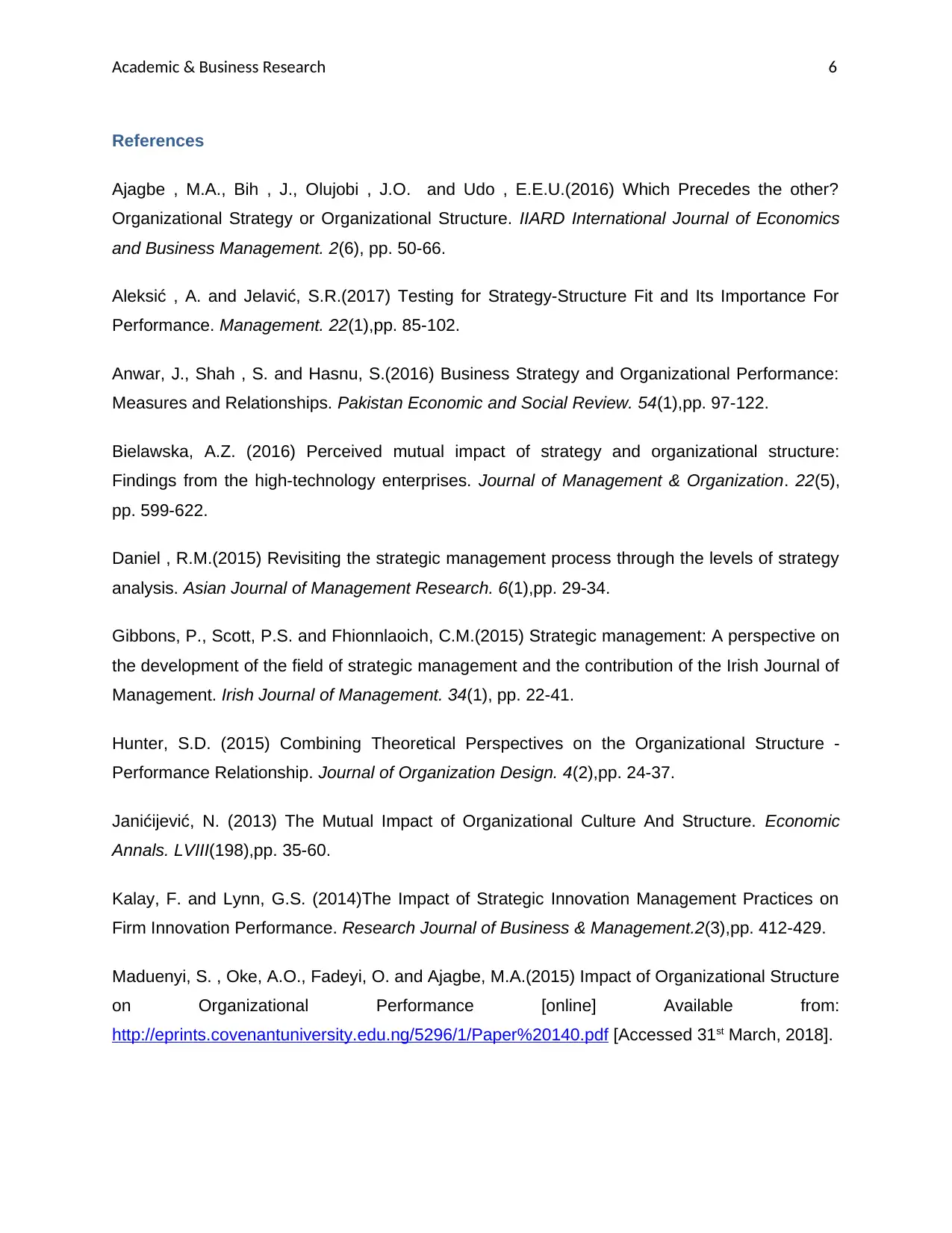
Academic & Business Research 6
References
Ajagbe , M.A., Bih , J., Olujobi , J.O. and Udo , E.E.U.(2016) Which Precedes the other?
Organizational Strategy or Organizational Structure. IIARD International Journal of Economics
and Business Management. 2(6), pp. 50-66.
Aleksić , A. and Jelavić, S.R.(2017) Testing for Strategy-Structure Fit and Its Importance For
Performance. Management. 22(1),pp. 85-102.
Anwar, J., Shah , S. and Hasnu, S.(2016) Business Strategy and Organizational Performance:
Measures and Relationships. Pakistan Economic and Social Review. 54(1),pp. 97-122.
Bielawska, A.Z. (2016) Perceived mutual impact of strategy and organizational structure:
Findings from the high-technology enterprises. Journal of Management & Organization. 22(5),
pp. 599-622.
Daniel , R.M.(2015) Revisiting the strategic management process through the levels of strategy
analysis. Asian Journal of Management Research. 6(1),pp. 29-34.
Gibbons, P., Scott, P.S. and Fhionnlaoich, C.M.(2015) Strategic management: A perspective on
the development of the field of strategic management and the contribution of the Irish Journal of
Management. Irish Journal of Management. 34(1), pp. 22-41.
Hunter, S.D. (2015) Combining Theoretical Perspectives on the Organizational Structure -
Performance Relationship. Journal of Organization Design. 4(2),pp. 24-37.
Janićijević, N. (2013) The Mutual Impact of Organizational Culture And Structure. Economic
Annals. LVIII(198),pp. 35-60.
Kalay, F. and Lynn, G.S. (2014)The Impact of Strategic Innovation Management Practices on
Firm Innovation Performance. Research Journal of Business & Management.2(3),pp. 412-429.
Maduenyi, S. , Oke, A.O., Fadeyi, O. and Ajagbe, M.A.(2015) Impact of Organizational Structure
on Organizational Performance [online] Available from:
http://eprints.covenantuniversity.edu.ng/5296/1/Paper%20140.pdf [Accessed 31st March, 2018].
References
Ajagbe , M.A., Bih , J., Olujobi , J.O. and Udo , E.E.U.(2016) Which Precedes the other?
Organizational Strategy or Organizational Structure. IIARD International Journal of Economics
and Business Management. 2(6), pp. 50-66.
Aleksić , A. and Jelavić, S.R.(2017) Testing for Strategy-Structure Fit and Its Importance For
Performance. Management. 22(1),pp. 85-102.
Anwar, J., Shah , S. and Hasnu, S.(2016) Business Strategy and Organizational Performance:
Measures and Relationships. Pakistan Economic and Social Review. 54(1),pp. 97-122.
Bielawska, A.Z. (2016) Perceived mutual impact of strategy and organizational structure:
Findings from the high-technology enterprises. Journal of Management & Organization. 22(5),
pp. 599-622.
Daniel , R.M.(2015) Revisiting the strategic management process through the levels of strategy
analysis. Asian Journal of Management Research. 6(1),pp. 29-34.
Gibbons, P., Scott, P.S. and Fhionnlaoich, C.M.(2015) Strategic management: A perspective on
the development of the field of strategic management and the contribution of the Irish Journal of
Management. Irish Journal of Management. 34(1), pp. 22-41.
Hunter, S.D. (2015) Combining Theoretical Perspectives on the Organizational Structure -
Performance Relationship. Journal of Organization Design. 4(2),pp. 24-37.
Janićijević, N. (2013) The Mutual Impact of Organizational Culture And Structure. Economic
Annals. LVIII(198),pp. 35-60.
Kalay, F. and Lynn, G.S. (2014)The Impact of Strategic Innovation Management Practices on
Firm Innovation Performance. Research Journal of Business & Management.2(3),pp. 412-429.
Maduenyi, S. , Oke, A.O., Fadeyi, O. and Ajagbe, M.A.(2015) Impact of Organizational Structure
on Organizational Performance [online] Available from:
http://eprints.covenantuniversity.edu.ng/5296/1/Paper%20140.pdf [Accessed 31st March, 2018].
Paraphrase This Document
Need a fresh take? Get an instant paraphrase of this document with our AI Paraphraser
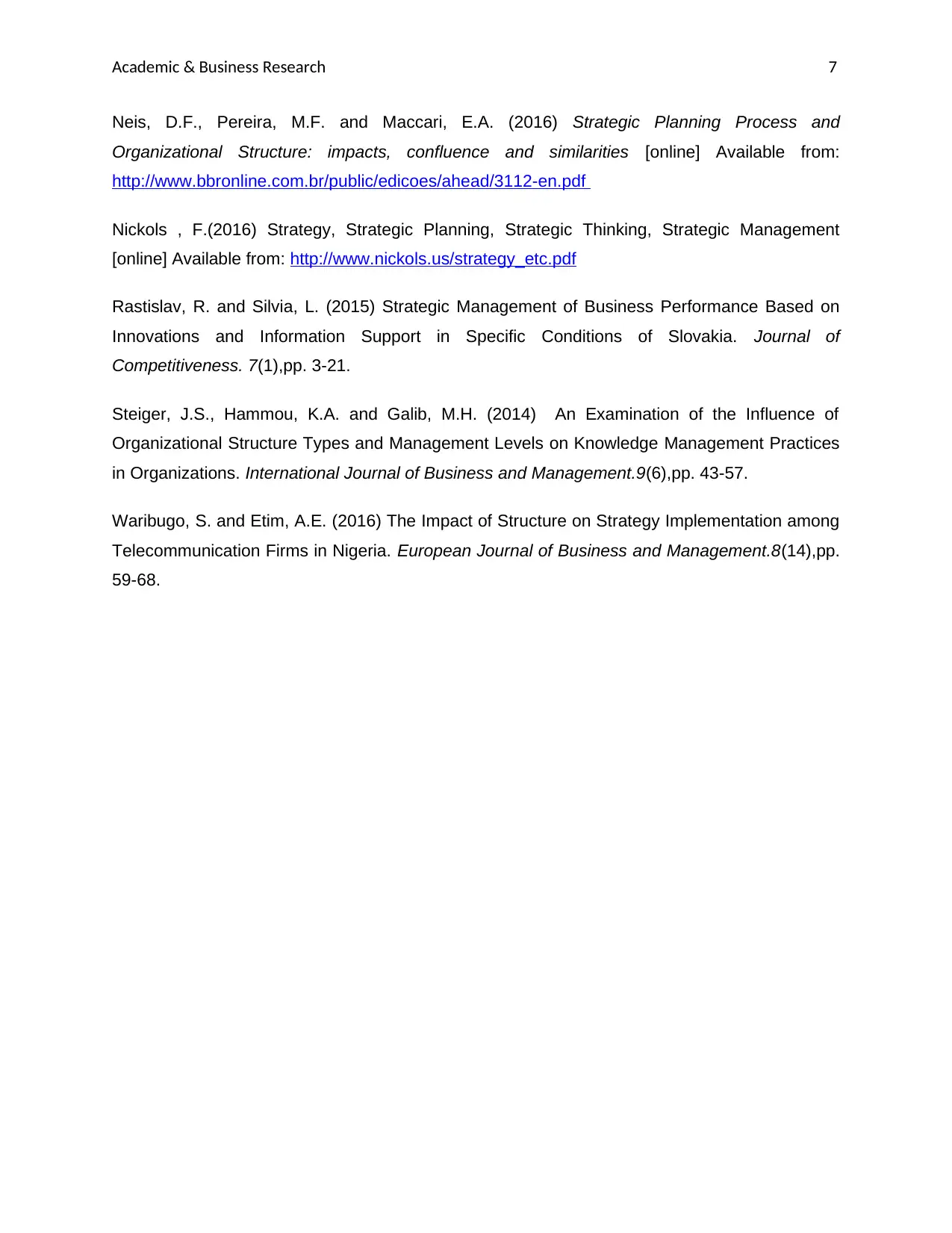
Academic & Business Research 7
Neis, D.F., Pereira, M.F. and Maccari, E.A. (2016) Strategic Planning Process and
Organizational Structure: impacts, confluence and similarities [online] Available from:
http://www.bbronline.com.br/public/edicoes/ahead/3112-en.pdf
Nickols , F.(2016) Strategy, Strategic Planning, Strategic Thinking, Strategic Management
[online] Available from: http://www.nickols.us/strategy_etc.pdf
Rastislav, R. and Silvia, L. (2015) Strategic Management of Business Performance Based on
Innovations and Information Support in Specific Conditions of Slovakia. Journal of
Competitiveness. 7(1),pp. 3-21.
Steiger, J.S., Hammou, K.A. and Galib, M.H. (2014) An Examination of the Influence of
Organizational Structure Types and Management Levels on Knowledge Management Practices
in Organizations. International Journal of Business and Management.9(6),pp. 43-57.
Waribugo, S. and Etim, A.E. (2016) The Impact of Structure on Strategy Implementation among
Telecommunication Firms in Nigeria. European Journal of Business and Management.8(14),pp.
59-68.
Neis, D.F., Pereira, M.F. and Maccari, E.A. (2016) Strategic Planning Process and
Organizational Structure: impacts, confluence and similarities [online] Available from:
http://www.bbronline.com.br/public/edicoes/ahead/3112-en.pdf
Nickols , F.(2016) Strategy, Strategic Planning, Strategic Thinking, Strategic Management
[online] Available from: http://www.nickols.us/strategy_etc.pdf
Rastislav, R. and Silvia, L. (2015) Strategic Management of Business Performance Based on
Innovations and Information Support in Specific Conditions of Slovakia. Journal of
Competitiveness. 7(1),pp. 3-21.
Steiger, J.S., Hammou, K.A. and Galib, M.H. (2014) An Examination of the Influence of
Organizational Structure Types and Management Levels on Knowledge Management Practices
in Organizations. International Journal of Business and Management.9(6),pp. 43-57.
Waribugo, S. and Etim, A.E. (2016) The Impact of Structure on Strategy Implementation among
Telecommunication Firms in Nigeria. European Journal of Business and Management.8(14),pp.
59-68.
1 out of 8
Related Documents
Your All-in-One AI-Powered Toolkit for Academic Success.
+13062052269
info@desklib.com
Available 24*7 on WhatsApp / Email
![[object Object]](/_next/static/media/star-bottom.7253800d.svg)
Unlock your academic potential
Copyright © 2020–2025 A2Z Services. All Rights Reserved. Developed and managed by ZUCOL.





